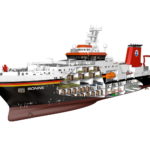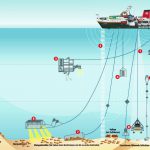Federal Chancellor Merkel is impressed: »Safe return to port«, minimal vib-ra-tion, high-quality laboratories, echo sounder, winches and heave com-pen-sation for handling scientific equipment in heavy seas. HANSA explains why »Sonne« is the most modern research ship in the world.
Politics demonstrated lip service to the maritime industry again and again in the past. Not always budget planning in Berlin[ds_preview] resulted in favorable projects for the industry.
However, high priority is placed in a special – albeit small – segment: research vessels, with the result that the German fleet is extensively modernized. In this area the political will to continue work among the world leaders is traceable and high costs are taken into account, too. The recent new »Sonne«, delivered by Meyer Werft and its affiliate Neptun, is considered the most advanced research ship in the world.
The German Federal Government contributes the majority (90%) of the 124,4mill. € construction costs. The remaining 10% share is covered by the five coastal federal states. German Chancellor Angela Merkel took the chance to baptize the »miracle« as she called it during the ceremony after 19 months of construction time (HANSA 08/2014).
»The vessel is used for multidisciplinary oceanography, chemistry, biology or geology«, says Lothar Meinders, Superintendent at the Leer-based shipping company Briese, which is entrusted with the ship management of the newbuilding by the Federal Ministry of Education and Research. Due to the size and design of »Sonne« the partially parallel use of larger scientific equipment is possible compared with other units. The vessel is highly energy efficient and environmentally friendly.
The ship classed by DNV GL has redundances and is ready for optimal and longer positioning even in bad weather conditions and it is designed according to the classification »GL +100 A5 E Nav OC special ship.« Most accurate positioning is important, because devices on cables and wires need to do pinpoint measurements or take samples in several thousand metres depth without losing their position, which might cause the failure of the research result.
There are high requirements for the crew so that researchers can work effectively on board. Ship operator Briese relies exclusively on German sailors. On board there is accommodation for 32 sailors and up to 40 scientists. This dimension is needed to make optimum use of the time at sea. Up to 15 scientists are required only for the handling of unmanned remoted operated vehicles (ROV) or the modern mini-submarine, for example.
While patrolling the newbuilding, you will recognize a distinct technical feature early on the foredeck: There are more sensors and radars close to the mast than usual. In addition to navigational sensors, there are those for weather data, wave measurement and even instruments for whale watching. The data are provided with an extremely high resolution. The ship features more network technology than many companies ashore. It is needed to record the amount of research data and process the information.
Back on the bridge the yardarms attract attention as these are no longer on the outside but integrated. The complete control system can be relocated there. Although the »Maria S. Merian«, until recently the most modern research ship, is designed to this principle, too, aboard the »Sonne« the starboard yardarm extends one metre further laterally. This actually enables a look beyond the ship. This comes with the advantage of being able to better supervise the work on deck and contributes to more precise positioning.
Safe return to port
As for the entire ship, several systems are redundant on the bridge. A special feature is the »safe return to port« system. It is intended to enable the crew to return to a safe haven in case of serious damage to the bridge or in a fire zone, caused for example by fire or an explosion. In case of damage, the captain can access all important nautical equipment in his room. The installations are harmonized with and linked to the bridge. All systems, even a seperated air-conditioning in the captains cabin, are controlled by the emergency generator if required. Though he lacks a direct view of the sea in front of him, monitors display camera images recorded on the foredeck.
The »Safe Return to Port« system refers not only to the control of the vessel. In an emergency an entire fire zone may fail. According to the shipping company the devices which are essential for surviving are more distinctly spread over 116m long and 20.6m wide »Sonne« as with previous vessels. Drinking water tanks and supply systems for example are provided separately in the bow and stern. There are redundant extinguishing devices and several rooms which are fully equipped with sleeping bags and most necessary equipment to ensure the survival of the crew to the next port. »In the development of the ship we paid much attention to redundancy – more than aboard previous research vessels,« Meinders says.
For example, propulsion systems, engine rooms with two diesel generators and all necessary auxiliary units each or the converter technology are located twice and independently. Besides the modern Common-Rail diesel generators with SCR after-treatment of exhaust gases nearly all pumps are frequency controlled. Waste heat of the diesel engines is optimally utilised with an absorption cooling device and evaporator.
Walking through the decks the excellent working conditions for scientists are appealing. The laboratory capacity is very high with over 500m2 in nine laboratories. The chemical laboratories equipped with special dishwashers, devices for water treatment, laboratory hoods or cooling and hot cabinets that can be set to exact temperatures of up to -80° give proof of the quality of the outfit. Fresh water, ultrapure water, and soft water may be provided. The pipes are resistant to chemicals accordingly. There are also special cooling laboratories which allow working at given temperatures between 0° and -28 °C with a tolerance of 0,5 Kelvin.
The working conditions also include the vessel’s high stability in water. Extendable side fins of 2.5m serve this purpose – these are more capacious than with comparable ships. They work like airplane wings with suction and upstream flow. In addition, a healing tank the water sloshes athwartships contrary to the list of the vessel. Sensors gather the remaining vessel moments very accurately. With this, undesired influences of the movements can be subtracted, e. g. from echo sounder data.
To search for mineral resources in the seabed, »Sonne« has four seismic compressors supplied by JP Sauer & Sohn – one more than »Maria S. Merian«.
Avoiding vibration on board is a very important aspect even more relevant as for commercial vessels. According to Meinders new benchmarks were defined here: »Sonne« is incredibly quiet. To achieve this, all drives, engines and pumps must feature double elastic bearing first cushioned on a pedestal, which in turn is cushioned on the ship’s structure. »The ship is so very quite that you even feel nothing in driving mode. You do not hear the shaft when standing next to it,« the expert says.
The »Sonne« has two diesel-electric engines with fixed pitch propeller from Becker Marine Systems. There are also two extendable and rotatable tunnel thrusters and a pumpjet. This ensures a high manoeuverability for DP works.
German research vessels feature an even pump jet at the bow, sucking water to eject it at the ship’s side. Contrary to conventional thrusters, these pumpjets do not generate bubbles under water, which could affect the echo-sounder. The echo sounder and winches are among the most prominent advantages of the newbuilding.
There are eight echo-sounders in the bow section. The biggest one has dimensions of 16m in length at 8m width. Thus, it is twice as large as on the »Maria S. Merian«. Equally important is the opening angle of 0.5°, the one with the highest resolution on the market. Thus, accurate readings with even higher resolution can be retrieved.
The developers have made a conscious decision for these dimensions, despite the risk that no bubbles on the hull may be tolerated to a greater length. The echo-sound would not operate properly then. »This is state of the art among shipbuilders of research vessels. Our units do not have a bulbous bow because this could result in bubbles being pulled in the area of the echo-sound system.«
This defines a contrast to merchant shipping. There are designs like so-called MALS system of Mitsubishi aimed at creating bubbles under the hull in order to decrease the resistance under water. As for »Sonne« the pump jet helps to push the water to the side. This is not very energy efficient. But you get a flat bottom without bubbles.
Winches and heave compensation
The prominent position of the newbuilding may also be related to the winches. According to the shipping company, arrangement, number and size of the electric winches by Hatlapa are »extraordinary«. These extend to 8.000m and 11.000m at a diameter of 11mm and 18mm. So there is no point in the oceans where »Sonne« could not work down to the seabed. Wires have a coaxial part that sends the data directly from the research equipment to the ship where they become available to all laboratories. The temperature is measured at approximately 4/1000 exactly. In addition, data on salinity, pressure, or jump layers are provided.
For the first time, a very modern, automatic heave compensation was installed, which forwards the signals directly to the winches. This prevents ship movements from being passed on to the sensitive instruments under water.
As on the »Maria S. Merian« all winches are mounted below deck, keeping them dry and clean, which has a very positive effect on longevity. When resuming aboard the wire is rinsed with fresh water, sprayed with air and dried.
Scientific specimens can be passed through directly into the hangar, so specimens must not be opened on deck in potentially difficult weather conditions.
Germany is one of the leading nations in research shipping. The operators of shipping company Briese are just as confident as German Chancellor Angela Merkel that the new »Sonne« will help to maintain this status in the future. Meanwhile, the newbuilding has already arrived in the South Pacific for its first mission.
Michael Meyer





















